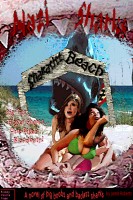Y'know, I've always found documentaries on abductions, hauntings, and possessions, with their straight-to-the-point dramatizations, much more frightening than any horror movie. With The Fourth Kind writer-director Olatunde Osunsanmi seems to be acutely aware of this, because he aims to provide just that experience. The first minute of the film is Milla Jovovich speaking directly into the camera about how every scene in the film is based on genuine archive material about an event in Nome, Alaska. Not only that, Osunsanmi frequently splits the screen to show us the archive footage (which he also shot, of course; it's not real) running simultaneously with the Jovovich-starring dramatization.
The plot concerns a psychologist, Abbie Tyler (Jovovich), conducting research on a series of related phenomena in Nome, Alaska after having just lost her husband in what she believes to be mysterious circumstances. Her patients all report seeing owls in their rooms, staring at them in the middle of the night; her husband believed UFOs were responsible for the odd occurrences; and she believes an intruder stabbed her husband in the middle of the night. See how it all adds up? As she digs deeper and captures a strange metallic voice on tape, her psychologist friend (Elias Koteas) visits to make sure she remains stable and an expert on the Sumerian language and proponent of the Ancient Astronaut Theory translates the voice for her. Meanwhile, as Abbie's patients start dying, the sheriff threatens to take her children away.
The obvious influence over The Fourth Kind is The Mothman Prophecies. They're both based on true stories. They share the similar subject matter of a small town being terrorized by strange, possibly extra-terrestrial-related events. They share a similar discordant soundtrack. They share Will Patton. They even share a similar shooting style, as Osunsanmi gives us a bewildering series of close-ups of lips and such that could have come right out of The Mothman Prophecies. The difficulty with imitating a great film is that you risk being compared unfavourable. Just based on this movie, I'd say Osunsanmi is a pretty talented guy, but he's clearly no Mark Pellington. The other influence is, surprisingly, E. Elias Merhige. The use of supposed archive footage and its parallel with dramatizations makes a statement about fiction vs reality that bares resemblance to Shadow of the Vampire. But more tellingly, some moments in the archive footage could have come out of Begotten. Well, Osunsanmi's got the right idea: if you're going to be influenced, might as well be influenced by the best.
Now I want to talk a little about this archive footage issue. Because it kind of makes you wonder, "Why?" It sounds good on paper and in one's head, but in realization, it may not have been so wise. What I mean is, while there are some good effects achieved, it does so at a cost. The first point is that it's redundant. Sometimes you're watching two identical scenes playing side-by-side in split screen filmed with two different actors. There's no need to have that. Going into a film like this, we're already willing to suspend our disbelief; we don't need archive footage. It has the opposite effect, in fact. It makes us have to suspend our disbelief on two orders, and this has a distancing effect, as in Brecht's plays. If the archive footage and dramatization were not both well-done, this might be helpful; but actually, Osunsanmi did a great job making both parts very eerie in that Mothman Prophecies way. Another benefit might be in getting this theme of fiction versus reality down. That strikes me as a waste of time. That theme has been around for so long that if you're going to use it, you'd better have something damn profound to say; and Osunsanmi doesn't have much of anything to say. There are still many benefits, such as the way both the archive footage and the dramatization can be very frightening, each in their own unique way. While they never quite complement each other the way Osunsanmi probably intended, they still work very well individually.
There is another issue resulting from this experiment. I don't want to go into it too much. But the fact that the main portion of the story we're witnessing is a dramatization calls far more attention than is beneficial to the style in which it's shot. Dramatizations, let's face it, are supposed to be plain and honest. So when you get crane shots and eagle-eye views, constantly roving cameras, it seems out of place. But maybe I'm just nit-picking at this point.
Despite the slight failure of the experiment, The Fourth Kind is a good horror film. Very good, in fact. It really freaked me out, and I'm not easily freaked. It freaked me out in the way The Mothman Prophecies does. At moments, Osunsanmi pumps the volume up, in that good exploitative genre film way, on some of The Mothman Prophecies' tricks to make it chill-inducing.
Help make this site more interesting through discussion:
The Fourth Kind (2009) - 3/4
Author: Jared Roberts
Subscribe to:
Post Comments (Atom)

0 comments:
Post a Comment